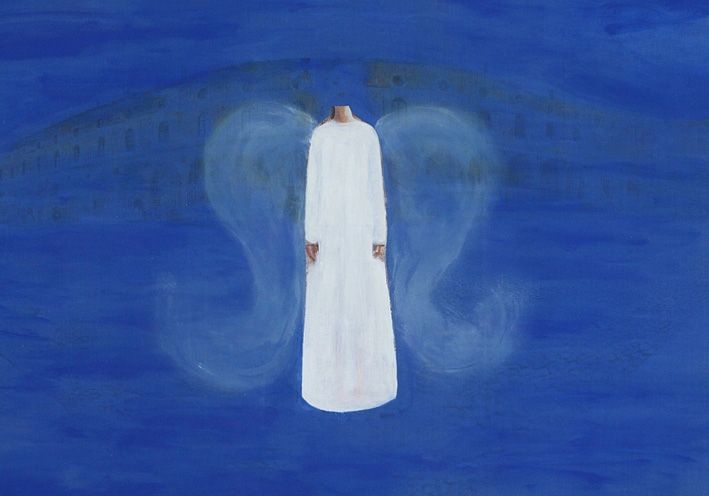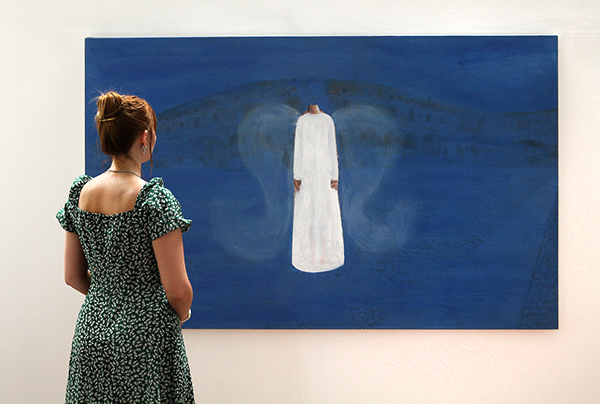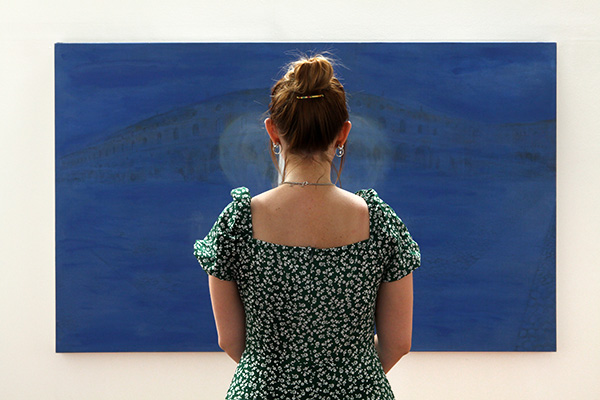Surplace

di LUCA SCARABELLI
2023
I dipinti di Riccardo Paracchini sono una testimonianza. Nel profondo è un pittore del trecento, un pittore antico che si rapporta con qualcosa di più in alto, celebra e racconta senza raccontare. Agli inizi degli anni ’90 (periodo che ha corrisposto a diverse collaborazioni e scorribande compiute con lui all’interno del mondo dell’arte, promosse e rinforzate poi con il nostro progetto della “gilda” di Vegetali Ignoti) ci fu una mostra a Lugano, intitolata “Manifestatori delle cose miracolose”. Riguardava l’arte italiana tra il ’300 e il ’400. Il catalogo esordiva così: “Impercioché noi siamo per la gratia di Dio manifestato agli uomini grossi che non sanno lettera, de le cose miracolose operate per virtù et in virtù de la santa fede…”. Sono parole del 1356, tratte da un documento di pittori senesi. Pittori mediatori tra la vita terrena e il mondo trascendente. Dipingere come atto di devozione. Per Riccardo credo sia un po’ la stessa cosa, ricercare l’assoluto e costruire la felicità eterna anche attraverso la pittura. L’arte è sacra.
Il suo linguaggio non è certo quello dei primitivi, anche se si ritrovano certe suggestioni ed affinità elettive per talune impostazioni compositive o per il rapporto dialettico con uno spazio che è ascetico. Il colore per Riccardo è determinante, è la storia della pittura. Il dipinto in mostra appartiene ad un suo progetto reiterato negli anni, a seguito di un periodo caratterizzato dal colore rosso: “Storia sulla pittura”. La pittura come allegoria ed esercizio morale.
L’immagine originale è stata tratta da una rivista di moda. La figura femminile ritratta, viene rivista e rimodellata secondo la sua visione. Viene proprio rivestita di un altro senso. Avvicinandosi si riescono a intravedere i minuscoli particolari della stampa su tela che riportano all’immagine primigenia, che non è negata totalmente, ma riequilibrata e rinnovata, rivisitata dal potere salvifico della pittura e dal colore. I colori sono sempre pochi, in questo caso due; il blu (pensando agli affreschi giotteschi) e il bianco che corrisponde al corpo, alla veste. Colori assoluti e universali che contengono tutto. La figura ha qualcosa di spettrale e non ha la testa, non rappresenta e non è il ritratto di un angelo anche se ha due grandi ali che si aprono leggere e diafane. Sono ali che attivano un’idea più che un moto. Impercioché l’opera di Riccardo ci invita in un altrove miracoloso, pur restando con i piedi per terra anche senza la testa.
GOOGLE TRANSLATION
Surplace
Riccardo Paracchini’s paintings are a testimony. Deep down he is a painter of the fourteenth century, an ancient painter who relates to something higher, celebrates and tells without telling. In the early 90s (a period that corresponded to various collaborations and forays made with him within the art world, promoted and reinforced with our project of the “guild” of Vegetali Ignoti) there was an exhibition in Lugano, entitled “Manifestatori delle cose miracolose”. It concerned Italian art between the 14th and 15th centuries. The catalogue began like this: “Imperciocché noi siamo per la grazia di God manifestato alle uomini grandi che non sapere, de le cose mirase operati per virtù e in virtù de la santa fede…”. These are words from 1356, taken from a document of Sienese painters. Painters mediators between earthly life and the transcendent world. Painting as an act of devotion. For Riccardo I think it’s a bit the same thing, seeking the absolute and building eternal happiness also through painting. Art is sacred.
His language is certainly not that of the primitives, even if certain suggestions and elective affinities can be found for certain compositional settings or for the dialectical relationship with a space that is ascetic. For Riccardo, color is crucial, it is the history of painting. The painting on display belongs to a project of his reiterated over the years, following a period characterized by the color red: “History on painting”. Painting as an allegory and moral exercise.
The original image was taken from a fashion magazine. The female figure portrayed is revised and remodeled according to his vision. It is actually dressed in another meaning. By getting closer, you can glimpse the tiny details of the print on canvas that bring you back to the original image, which is not totally denied, but rebalanced and renewed, revisited by the saving power of painting and color. The colors are always few, in this case two; the blue (thinking of Giotto’s frescoes) and the white that corresponds to the body, to the dress. Absolute and universal colors that contain everything. The figure has something spectral and does not have a head, it does not represent and is not the portrait of an angel even if it has two large wings that open lightly and diaphanously. They are wings that activate an idea more than a movement. Because Riccardo’s work invites us to a miraculous elsewhere, while remaining with our feet on the ground even without a head.
Altri Testi…

